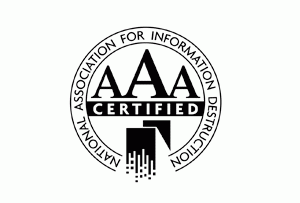Benefits of Imaging
Disaster Recovery:
The majority of companies do not have adequate plans for recovery of
their critical information and documents. Over 90% of all companies’
records and vital documents are on paper. Obviously, these documents are
susceptible to all forms of loss or destruction (e.g., fire, flood,
theft, etc.). Unfortunately approximately 60% of companies that cannot
recover critical documents and data within 90 days of a disaster end up
going out of business.x
Conversion of paper documents to portable electronic files (e.g., PDF files), via document imaging, provides for easy, inexpensive and safe storage of all company documents. Furthermore, should recovery of documents following a disaster become necessary, retrieval and duplication of electronically archived documents is quick and inexpensive, and minimizes the amount of time of business interruption.
Reduced Office Expenses:
On average, companies make 19 copies of each document; spend $20 in
labor filing each document; spend $120 in labor searching for misfiled
documents; lose one out of every 20 documents; and spend $250 recreating
each lost document. Furthermore, professionals spend approximately 10%
of their time reading information and up to 50% of their time looking
for it.
Conversion of paper documents to portable electronic files (e.g., PDF files), via document imaging, significantly reduces the overall costs associated with copying, transferring, filing, locating and recreating lost office documents. Paper documents converted into searchable electronic files also increase office efficiencies, and help reduce overall administrative labor costs.
The federal government has recognized the cost-saving benefits of reducing paper since the passage of the Paperwork Reduction Act in 1995.
e-Commerce Information Transfer:
Efficient document management and warehousing is essential to the entire
e-information delivery process. A successful document management system
provides e-organizations with the ability to rapidly bring together
information from any source, manage it, transport it, and utilize it in
today’s e-environments. Electronic document images transform paper
documents into readily available and transportable e-documents. These
electronic documents can be available instantaneously in multiple
corporate locations and/or can be provided to e-clients immediately upon
request.
Improved transfer of documents and information, via document imaging, is the key to maintaining a competitive edge it today’s fast-paced e-commerce environment.
Reducing Document Storage Space and Costs:
Document storage and retrieval expenses are often significant and become
a major component of your business’s overhead. Even though the initial
cost for off-site storage of paper documents appears reasonable, the
hidden costs associated with document retrieval and duplication of
missing documents are substantial.
Maintaining your important corporate and/or personal documents in a searchable digital format on CD-ROMs, DVDs or your computer hard-drive significantly reduces the amount of space you need to store these documents and the costs (whether or not you store documents in-house or with a vendor) for storage. One DVD, which can hold up-to 90,000 electronic images, can take the place of 6-four drawer filing cabinets. Obviously, the cost savings (approximately $125-$200/cabinet/year) associated with reducing the need for office space dedicated to document storage, alone, is substantial.
Additional savings realized by reducing your administrative and secretarial costs associated with paper document filing, document retrieval and re-filing, and recreation of lost/missing documents, makes conversion of paper documents to digital images a highly significant cost saving factor in any office environment.
Benefits of Outsourcing Document Imaging:
In order to fully realize the overall document management and economic
advantages associated with maintaining documents in a digital format
created via document imaging, significant capital investments in both
hardware and software, and training are required. Furthermore, "in order
to do it right" proper planning and personnel resourcing is essential,
and adequate time must be factored in order to "ramp-up" properly, and
efficiently.
Outsourcing complete or partial document imaging to a qualified vendor with "state of the art", production level equipment and software, as well as trained and experienced personnel, provide an economic and rapid deployed solution that will allow you to focus on your current business issues while gaining the advantages associated with utilizing digitized documents.
Advantages of Digital Imaged Documents Over Paper and Microfilm:
In today’s fast-paced world and highly competitive work environments,
speed, efficiency, accuracy and cost controls are the keys to success.
Converting paper and microfilm documents into electronically searchable
digital images, via imaging and indexing, effectively addresses each of
these elements of success. In addition, because of the recent advances
in hardware and software technologies, the cost of converting hard copy
paper documents and microfilm into electronic documents has been reduced
to only pennies per image.
Immediate advantages you will recognize by converting your documents to Digital Imaged Documents:
- Increased productivity
- Fast, easy retrieval from any PC
- Portability of documents via e-mail and e-fax
- Effortless and instantaneous document distribution to multiple locations
- Document collaboration across office networks (intranet and/or the Internet)
- Fewer lost/misfiled documents
- Efficient archiving and back-up of records
- Portability for home-office or travel
- Improved disaster recovery
- Reduced storage and duplication costs
- (and last but not least) Less paper cuts
To learn more about our document imaging solutions, simply call 866-798-7400, or email customerservice@citadelim.com and a member of our knowledgeable and experienced account executive team will assist you.



